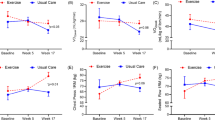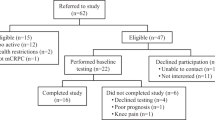Abstract
Side effects accompanying androgen deprivation therapy (ADT), including sarcopenia, loss of bone mass and reduction in muscle strength, can compromise physical function, particularly in older patients. Exercise, specifically resistance training, may be an effective and cost-efficient strategy to limit or even reverse some of these adverse effects during and following therapy. In this review, we discuss common morphological and physiological ADT-related side effects or ‘Androgen Deprivation and Sarcopenia-Related Disorders’ and the existing clinical trials incorporating physical exercise in prostate cancer patients receiving active therapy. Further, training concepts and guidelines are provided for prescribing resistance exercise programs for this population.
This is a preview of subscription content, access via your institution
Access options
Subscribe to this journal
Receive 4 print issues and online access
$259.00 per year
only $64.75 per issue
Buy this article
- Purchase on Springer Link
- Instant access to full article PDF
Prices may be subject to local taxes which are calculated during checkout

Similar content being viewed by others
References
Parkin DM, Bray F, Ferlay J, Pisani P . Global cancer statistics, 2002. CA Cancer J Clin 2005; 55: 74–108.
Yancik R . Cancer burden in the aged: an epidemiologic and demographic overview. Cancer 1997; 80: 1273–1283.
Yancik R, Ganz PA, Varricchio CG, Conley B . Perspectives on comorbidity and cancer in older patients: approaches to expand the knowledge base. J Clin Oncol 2001; 19: 1147–1151.
McCredie M, Cox B . Prostate-specific antigen testing for prostate cancer: the case for informed consent. Med J Aust 1998; 169: 9–10.
Moul JW . Prostate specific antigen only progression of prostate cancer. J Urol 2000; 163: 1632–1642.
Rashid MH, Chaudhary UB . Intermittent androgen deprivation therapy for prostate cancer. Oncologist 2004; 9: 295–301.
Chodak GW . Comparing treatments for localized prostate cancer – persisting uncertainty. JAMA 1998; 280: 1008–1010.
Ransohoff DF, McNaughton Collins M, Fowler FJ . Why is prostate cancer screening so common when the evidence is so uncertain? A system without negative feedback. Am J Med 2002; 113: 663–667.
Galvão DA, Newton RU . Review of exercise intervention studies in cancer patients. J Clin Oncol 2005; 23: 899–909.
Taaffe DR . Sarcopenia. Exercise as a treatment strategy. Aust Fam Physician 2006; 35: 130–134.
Galvão DA, Taaffe DR . Resistance exercise dosage in older adults: single- versus multiset effects on physical performance and body composition. J Am Geriatr Soc 2005; 53: 2090–2097.
Courneya KS . Exercise in cancer survivors: an overview of research. Med Sci Sports Exerc 2003; 35: 1846–1852.
Segal RJ, Reid RD, Courneya KS, Malone SC, Parliament MB, Scott CG et al. Resistance exercise in men receiving androgen deprivation therapy for prostate cancer. J Clin Oncol 2003; 21: 1653–1659.
Galvão DA, Nosaka K, Taaffe DR, Spry N, Kristjanson LJ, McGuigan MR et al. Resistance training and reduction of treatment side effects in prostate cancer patients. Med Sci Sports Exerc 2006; 38: 2045–2052.
Schmitz KH, Ahmed RL, Hannan PJ, Yee D . Safety and efficacy of weight training in recent breast cancer survivors to alter body composition, insulin, and insulin-like growth factor axis proteins. Cancer Epidemiol Biomarkers Prev 2005; 14: 1672–1680.
Kaisary AV . Evaluating the use of early hormonal therapy in patients with localised or locally advanced prostate cancer. Prostate Cancer Prostatic Dis 2005; 8: 140–151.
Moyad MA . Promoting general health during androgen deprivation therapy (ADT): a rapid 10-step review for your patients. Urol Oncol 2005; 23: 56–64.
Shahinian VB, Kuo YF, Freeman JL, Goodwin JS . Risk of the ‘androgen deprivation syndrome’ in men receiving androgen deprivation for prostate cancer. Arch Intern Med 2006; 166: 465–471.
Smith MR, Finkelstein JS, McGovern FJ, Zietman AL, Fallon MA, Schoenfeld DA et al. Changes in body composition during androgen deprivation therapy for prostate cancer. J Clin Endocrinol Metab 2002; 87: 599–603.
Greenspan SL, Coates P, Sereika SM, Nelson JB, Trump DL, Resnick NM . Bone loss after initiation of androgen deprivation therapy in patients with prostate cancer. J Clin Endocrinol Metab 2005; 90: 6410–6417.
Chen Z, Maricic M, Nguyen P, Ahmann FR, Bruhn R, Dalkin BL . Low bone density and high percentage of body fat among men who were treated with androgen deprivation therapy for prostate carcinoma. Cancer 2002; 95: 2136–2144.
Basaria S, Lieb II J, Tang AM, DeWeese T, Carducci M, Eisenberger M et al. Long-term effects of androgen deprivation therapy in prostate cancer patients. Clin Endocrinol (Oxford) 2002; 56: 779–786.
Braga-Basaria M, Muller DC, Carducci MA, Dobs AS, Basaria S . Lipoprotein profile in men with prostate cancer undergoing androgen deprivation therapy. Int J Impot Res 2006; 18: 494–498.
Sharifi N, Gulley JL, Dahut WL . Androgen deprivation therapy for prostate cancer. JAMA 2005; 294: 238–244.
Shahinian VB, Kuo YF, Freeman JL, Goodwin JS . Risk of fracture after androgen deprivation for prostate cancer. N Engl J Med 2005; 352: 154–164.
Smith MR, Lee WC, Brandman J, Wang Q, Botteman M, Pashos CL . Gonadotropin-releasing hormone agonists and fracture risk: a claims-based cohort study of men with nonmetastatic prostate cancer. J Clin Oncol 2005; 23: 7897–7903.
Higano CS . Bone loss and the evolving role of bisphosphonate therapy in prostate cancer. Urol Oncol 2003; 21: 392–398.
Petrella JK, Kim JS, Tuggle SC, Hall SR, Bamman MM . Age differences in knee extension power, contractile velocity, and fatigability. J Appl Physiol 2005; 98: 211–220.
Basaria S, Muller DC, Carducci MA, Egan J, Dobs AS . Hyperglycemia and insulin resistance in men with prostate carcinoma who receive androgen-deprivation therapy. Cancer 2006; 106: 581–588.
Fowler Jr FJ, McNaughton Collins M, Walker Corkery E, Elliott DB, Barry MJ . The impact of androgen deprivation on quality of life after radical prostatectomy for prostate carcinoma. Cancer 2002; 95: 287–295.
Spry NA, Kristjanson L, Hooton B, Hayden L, Neerhut G, Gurney H et al. Adverse effects to quality of life arising from treatment can recover with intermittent androgen suppression in men with prostate cancer. Eur J Cancer 2006; 42: 1083–1092.
Yaffe K, Lui LY, Zmuda J, Cauley J . Sex hormones and cognitive function in older men. J Am Geriatr Soc 2002; 50: 707–712.
Shores MM, Sloan KL, Matsumoto AM, Moceri VM, Felker B, Kivlahan DR . Increased incidence of diagnosed depressive illness in hypogonadal older men. Arch Gen Psychiatry 2004; 61: 162–167.
Herr HW . Quality of life in prostate cancer patients. CA Cancer J Clin 1997; 47: 207–217.
Galvão DA, Newton RU, Taaffe DR . Anabolic responses to resistance training in older men and women: a brief review. J Aging Phys Act 2005; 13: 343–358.
Windsor PM, Nicol KF, Potter J . A randomized, controlled trial of aerobic exercise for treatment-related fatigue in men receiving radical external beam radiotherapy for localized prostate carcinoma. Cancer 2004; 101: 550–557.
Thompson IM, Pauler DK, Goodman PJ, Tangen CM, Lucia MS, Parnes HL et al. Prevalence of prostate cancer among men with a prostate-specific antigen level ⩽4.0 ng per milliliter. N Engl J Med 2004; 350: 2239–2246.
Hakkinen K, Pakarinen A, Kraemer WJ, Newton RU, Alen M . Basal concentrations and acute responses of serum hormones and strength development during heavy resistance training in middle-aged and elderly men and women. J Gerontol A Biol Sci Med Sci 2000; 55: B95–B105.
Kraemer WJ, Hakkinen K, Newton RU, Nindl BC, Volek JS, McCormick M et al. Effects of heavy-resistance training on hormonal response patterns in younger vs older men. J Appl Physiol 1999; 87: 982–992.
Loblaw DA, Mendelson DS, Talcott JA, Virgo KS, Somerfield MR, Ben-Josef E et al. American society of clinical oncology recommendations for the initial hormonal management of androgen-sensitive metastatic, recurrent, or progressive prostate cancer. J Clin Oncol 2004; 22: 2927–2941.
Sato N, Akakura K, Isaka S, Nakatsu H, Tanaka M, Ito H et al. Intermittent androgen suppression for locally advanced and metastatic prostate cancer: preliminary report of a prospective multicenter study. Urology 2004; 64: 341–345.
Taaffe DR, Pruitt L, Pyka G, Guido D, Marcus R . Comparative effects of high- and low-intensity resistance training on thigh muscle strength, fiber area, and tissue composition in elderly women. Clin Physiol 1996; 16: 381–392.
Taaffe DR, Duret C, Wheeler S, Marcus R . Once-weekly resistance exercise improves muscle strength and neuromuscular performance in older adults. J Am Geriatr Soc 1999; 47: 1208–1214.
Author information
Authors and Affiliations
Corresponding author
Rights and permissions
About this article
Cite this article
Galvão, D., Taaffe, D., Spry, N. et al. Exercise can prevent and even reverse adverse effects of androgen suppression treatment in men with prostate cancer. Prostate Cancer Prostatic Dis 10, 340–346 (2007). https://doi.org/10.1038/sj.pcan.4500975
Received:
Accepted:
Published:
Issue Date:
DOI: https://doi.org/10.1038/sj.pcan.4500975
Keywords
This article is cited by
-
Physical activity behaviour change in black prostate cancer survivors: a qualitative study using the Behaviour Change Wheel
Supportive Care in Cancer (2024)
-
Coping strategies in active and inactive men with prostate cancer: a qualitative study
Journal of Cancer Survivorship (2022)
-
Plausible conditions and mechanisms for increasing physical activity behavior in men with prostate cancer using patient education interventions: sequential explanatory mixed studies synthesis
Supportive Care in Cancer (2022)
-
Barriers and facilitators related to undertaking physical activities among men with prostate cancer: a scoping review
Prostate Cancer and Prostatic Diseases (2021)
-
Psychological distress in men with prostate cancer undertaking androgen deprivation therapy: modifying effects of exercise from a year-long randomized controlled trial
Prostate Cancer and Prostatic Diseases (2021)



